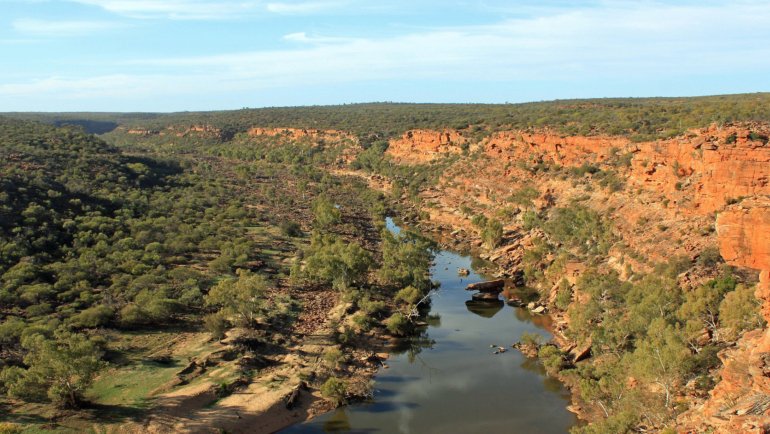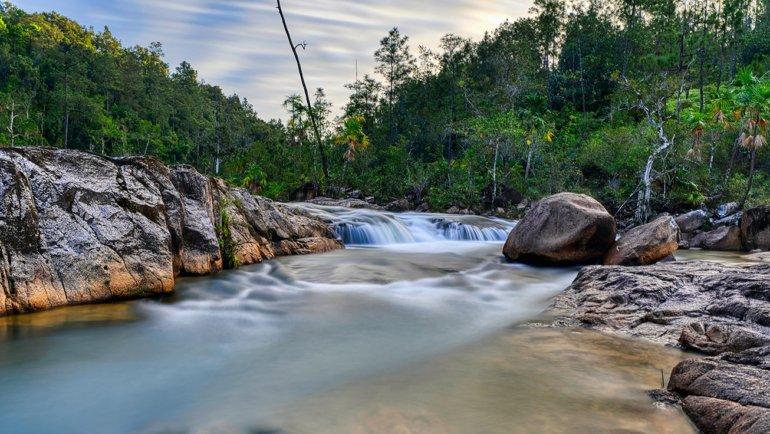Located in South Asia, Bangladesh shares borders with India to the north, east, and west, Myanmar to the southeast, and the Bay of Bengal to the south. It has a population of over 160 million people, making it the eighth most populous country in the world. The official language is Bengali, and the capital and largest city is Dhaka.
It’s a land of rivers, with the Ganges, Brahmaputra, and Meghna rivers forming the delta that the country is located in. Agriculture is the mainstay of the economy, with rice as the principal crop.
Bangladesh is home to a diverse range of wildlife, including many endangered and threatened species.
Here are 11 notable wildlife species found in Bangladesh:
1. Bengal Tiger

- Scientific name: Panthera tigris tigris
- Type of animal: Mammal
- Where found in the country: Sundarbans, a mangrove forest located in the southwestern part of Bangladesh.
- Conservation status: Critically Endangered
The Royal Bengal tiger is the national animal of Bangladesh. It’s also referred to as the Bengal tiger. It’s known for its reddish-orange coat with black stripes and a white underbelly.
Royal Bengal tigers are apex predators and are known for their strength, agility, and stealth. They are solitary animals and are primarily active during the night, spending much of the day resting in the shade.
The conservation status of the Royal Bengal tiger varies across its range, but in general, it is considered to be a highly endangered species. In Nepal, India, and Bhutan, it’s listed as endangered, while in Bangladesh and China, it’s listed as critically endangered
★ Did you know? Ming, a 19-year-old Bengal tiger, passed away in 2019 after spending most of his life living in a New York City apartment. Ming’s owner, Antoine Yates, had acquired the tiger as a cub and kept him as a pet in his apartment in Harlem, which was against the law.
2. Fishing Cat
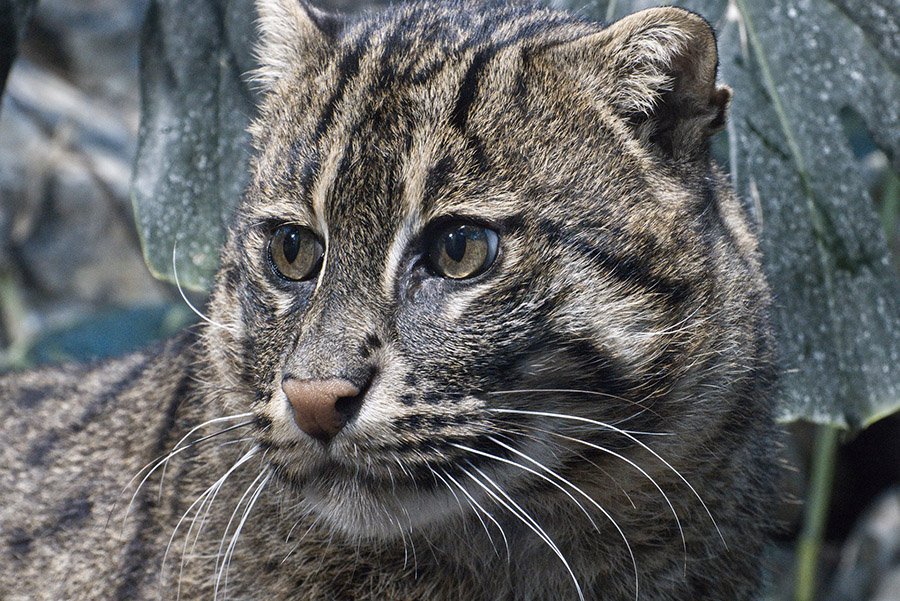
- Scientific name: Prionailurus viverrinus
- Type of animal: Mammal
- Where found in the country: Wetlands and swamps of Bangladesh.
- Conservation status: Vulnerable
The fishing cat is a unique and fascinating medium-sized wild cat found in Bangladesh. It has a stocky build body, with short, powerful legs that are adapted for swimming and hunting in water.
The fur of the fishing cat is short, dense, and has a brownish-yellow color, with darker spots and stripes that help it to blend in with its surroundings. Its eyes are large and wide-set, providing excellent night vision for hunting.
Fishing cats are solitary and nocturnal animals, and they are known for their vocalizations, including meows, growls, and purrs. They are generally shy and elusive and prefer to avoid human contact.
★ Did you know? The fishing cat is an adept swimmer and is known to dive into the water to catch fish, crabs, and other aquatic prey.
3. Indian Flying Fox
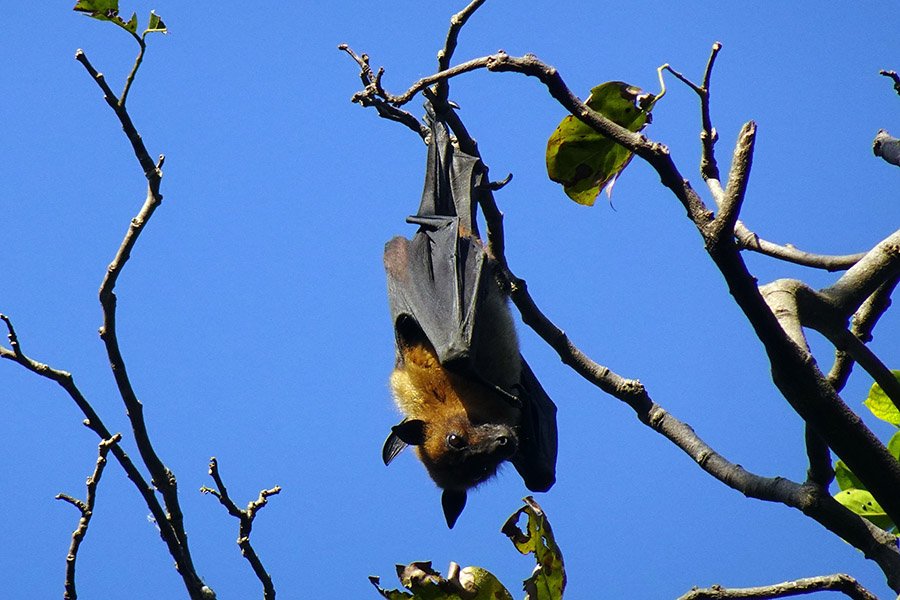
- Scientific name: Pteropus medius, previously Pteropus giganteus
- Type of animal: Mammal
- Where found in the country: The southern and southeastern parts of the country.
- Conservation status: Least Concern
The Indian flying fox is a species of megabat, commonly known as the fruit bat, found in many parts of South Asia, including Bangladesh. It is a large bat, with a wingspan of up to 1.5 meters, and is primarily black or dark brown in color. Its fur is long and silky, and it has a dog-like face with sharp teeth.
Indian Flying Foxes are primarily frugivores, feeding on fruit and nectar, and they are important seed dispersers and pollinators in the ecosystems where they live. They are known to roost in large colonies of about thousands, often in trees, or on man-made structures like buildings or bridges.
During the day, they hang upside down from their roosts, with their wings folded around their body.
★ Did you know? The Indian flying foxes are important pollinators in the ecosystems where they live.
4. Gaur
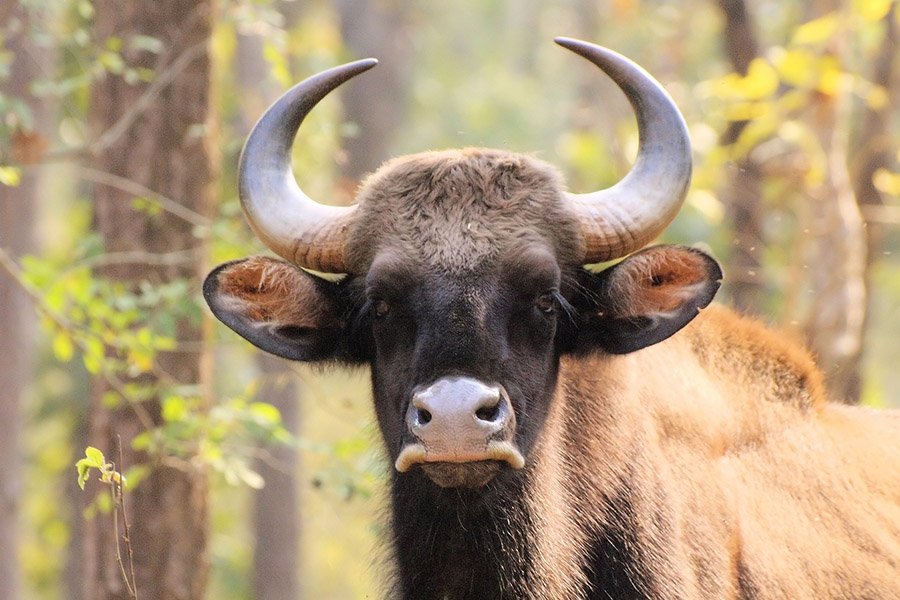
- Scientific name: Bos gaurus
- Type of animal: Mammal
- Where found in the country: Chittagong Hill Tracts and Sylhet region.
- Conservation status: Vulnerable
The gaur, also known as Indian bison, is a large and powerful bovine species found in various South and Southeast Asia. They are the largest wild cattle species in the world, with males standing up to six feet tall at the shoulder and weighing up to 2,200 pounds.
Gaur has a dark brown or black coat with white stockings on their lower legs and white markings on their face. Both males and females have curved horns that can grow up to three feet long in males.
★ Did you know? Gaurs are capable of jumping over high obstacles, despite their large size and weight. They can jump up to six feet in the air from a standing position, and can also jump over fences and other obstacles that are over five feet tall.
5. Risso’s Dolphin
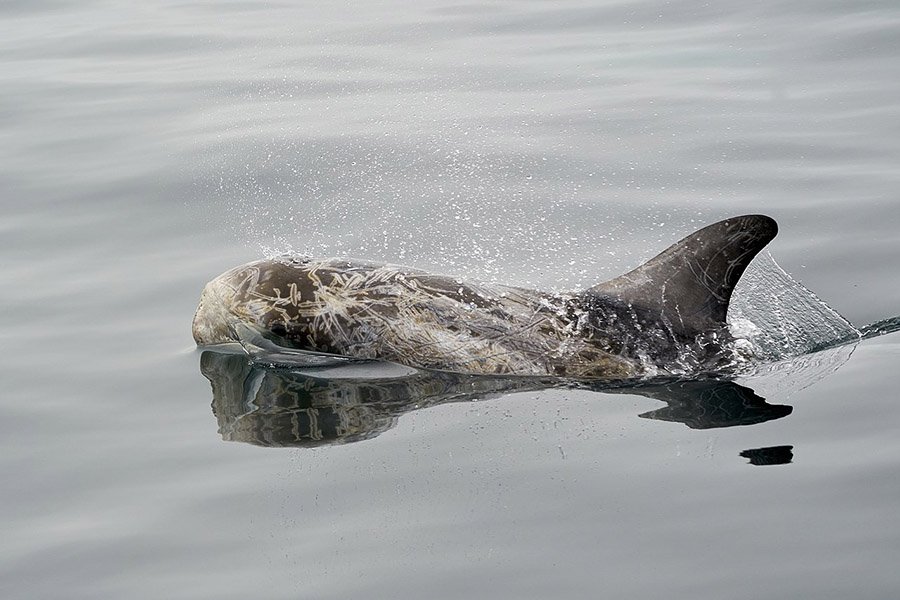
- Scientific name: Grampus griseus
- Type of animal: Mammal
- Where found in the country: In the Bay of Bengal, particularly in the offshore waters near Saint Martin’s Island and the Chittagong Hill Tracts.
- Conservation status: Least Concern
Risso’s dolphin is a large and robust species of dolphin found in deep waters around the world, including the temperate, tropical, and subtropical regions of the Atlantic, Pacific, and Indian Oceans.
Risso’s dolphins have a distinctive appearance, with a stocky body and a rounded head. They are gray in color, with a white or light-colored “anchor-shaped” patch on their sides. As they age, they become more scarred and their coloration can become lighter.
★ Did you know? Pelorus Jack was a famous Risso’s dolphin who was known for guiding boats across Cook Strait in New Zealand in the late 19th and early 20th centuries. He was first spotted by a sailor in 1888 and became a regular sight for boats traveling through.
He would swim alongside and guide them through the treacherous waters. He was so beloved by the people of New Zealand that in 1904, the government passed a special law protecting him from harm.
6. Bengal Florican
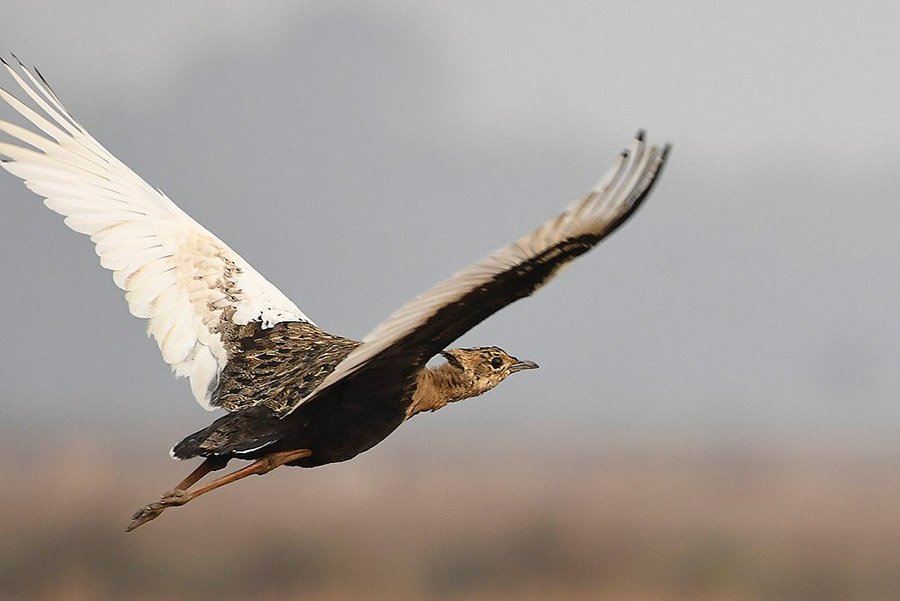
- Scientific name: Houbaropsis bengalensis
- Type of animal: Bird
- Where found in the country: Grasslands and wetlands of Bangladesh.
- Conservation status: Critically Endangered
The Bengal florican is a critically endangered bird species that is found in grasslands and wetlands of Southeast Asia, including Bangladesh.
It is a large, ground-dwelling bird that is known for its striking appearance, with a black head, white neck and upper breast, and chestnut underparts.
The male has long, white, drooping feathers on the nape and sides of the neck, and during the breeding season, it has a distinctive courtship display that involves jumping and calling. The female, on the other hand, is smaller and less colorful than the male.
★ Did you know? Male Bengal floricans have a unique courtship display that involves leaping and calling while displaying their elongated white neck feathers.
7. Blue Whale

- Scientific name: Balaenoptera musculus
- Type of animal: Mammal
- Where found in the country: Bay of Bengal.
- Conservation status: Endangered
Blue whales are the largest animals on the planet. They can grow up to 100 feet long and weigh up to 150 tons. They have a distinctive mottled blue-gray coloration on their skin with a white underside. The body is streamlined and tapered at both ends, with a narrow head and a broad, flat rostrum or snout.
Blue whales are baleen whales, which means they have rows of long, narrow plates called baleen in their mouths instead of teeth. They use these baleen plates to filter huge volumes of seawater and trap small, shrimp-like crustaceans called krill, which they swallow in vast quantities.
Blue whales are highly migratory and are known to travel thousands of miles each year between their feeding and breeding grounds.
★ Did you know? Blue whales have one of the largest mouths of any animal on Earth, measuring up to 4 feet (1.2 meters) wide. In addition, their tongue can weigh as much as an elephant, which is approximately 5,000 to 6,000 pounds (2,268 to 2,722 kg).
8. Indian Pangolin

- Scientific name: Manis crassicaudata
- Type of animal: Mammal
- Where found in the country: Lawachara National Park, Satchari National Park, Bhawal National Park, Rema-Kalenga Wildlife Sanctuary, and Madhabpur Lake Wildlife Sanctuary.
- Conservation status: Endangered
The Indian pangolin, also known as the scaly anteater, is a fascinating creature with a unique appearance that sets it apart from other animals. It has a small head with a pointed snout that it uses to sniff out insects. Its eyes are small and black.
Its body is covered in thick, armor-like scales that provide it with excellent protection from predators. These scales are made of keratin, the same material that makes up human hair and nails. The scales are a dark brown color and have a rough texture.
★ Did you know? The Indian pangolin has poor eyesight, so it relies heavily on its keen sense of smell and hearing to navigate its environment.
9. Bengal Slow Loris

- Scientific name: Nycticebus bengalensis
- Type of animal: Mammal
- Where found in the country: Forests and wooded areas of Bangladesh, particularly in the eastern and northeastern parts of the country.
- Conservation status: Endangered
The Bengal slow loris is a small, nocturnal primate found in the forests of Bangladesh, India, and other parts of Southeast Asia. It belongs to the family Lorisidae and is characterized by its round head, large eyes, and slow, deliberate movements.
It has a distinctive appearance with soft, thick fur that ranges in color from light brown to dark reddish-brown. Its face is dominated by two large, forward-facing eyes that are surrounded by dark circles, giving it a distinctive look that is often described as “cute” or “endearing.”
★ Did you know? The Bengal slow loris produces a toxic secretion from glands on its elbows, which it then spreads on its fur. This secretion serves as a defense mechanism against predators and is also used for communication with other members of its species.
10. Binturong
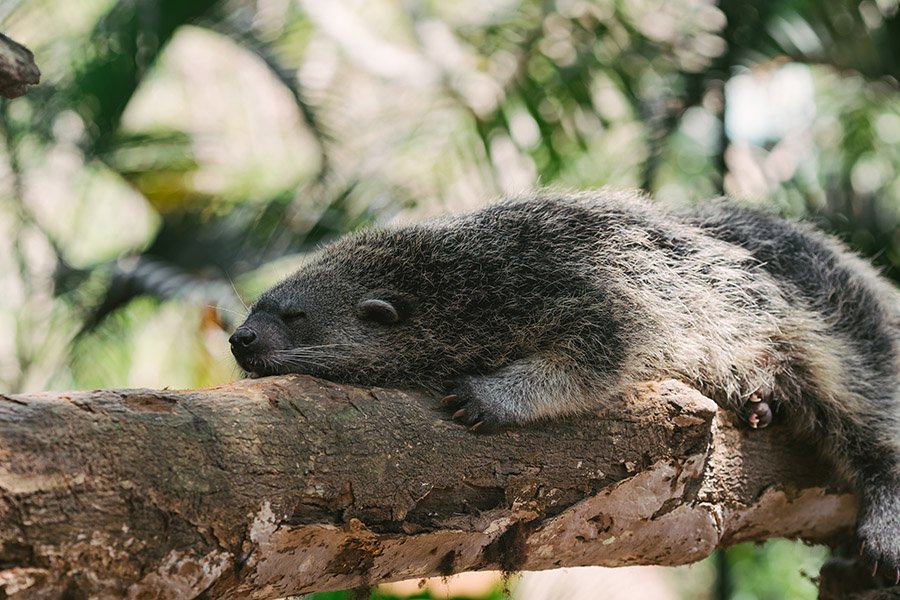
- Scientific name: Arctictis binturong
- Type of animal: Mammal
- Where found in the country: Southeastern regions of Bangladesh.
- Conservation status: Vulnerable
The binturong is a large, arboreal mammal that belongs to the family Viverridae, which also includes civets and genets. It is also known as the bearcat due to its shaggy fur and bear-like appearance, but it is not closely related to either bears or cats.
Binturongs are primarily found in the forests of Southeast Asia, including countries such as Indonesia, Malaysia, Thailand, and the Philippines. They have also been reported in some parts of Bangladesh, although sightings of this species in Bangladesh are relatively rare.
Binturongs have shaggy, dark fur that ranges from black to dark brown. They have a long, prehensile tail that can grip onto tree branches, allowing them to move easily through the forest canopy. They also have long, curved claws that are adapted for climbing and grasping prey.
★ Did you know? Binturongs are generally considered to be shy and elusive animals.
11. Asian Elephant
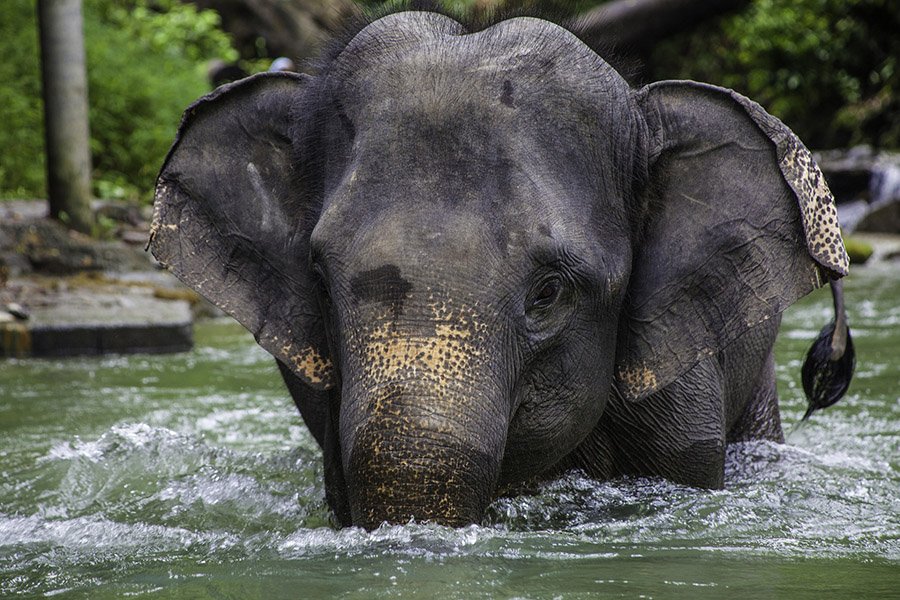
- Scientific name: Elephas maximus
- Type of animal: Mammal
- Where found in the country: Chittagong Hill Tracts and many forested areas of Bangladesh.
- Conservation status: Endangered
The Asian elephant is a species of large land mammal native to various parts of Asia, including India, Sri Lanka, Thailand, Bangladesh, and Malaysia. They are the largest living land animals in Asia and are highly revered in many cultures.
Asian elephants have several distinguishing features, including their grey-brown skin, large ears, and curved tusks. They are smaller than their African elephant counterparts, with adult males weighing around 5,500 kg (12,000 lb) and standing about 3 meters (10 feet) tall at the shoulder.
★ Did you know? In Asian elephant herds, the young calves are typically cared for not only by their mother but also by other female elephants in the group. These “aunties” help with tasks such as nursing, protecting, and teaching the calves as they grow and develop.




